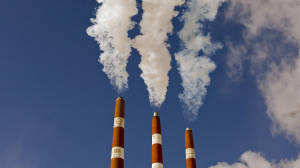Norway opens major facility to test carbon capture
 Norway on Monday launched the world’s largest facility of its kind to develop carbon capture and storage (CCS), the so-far commercially unproven technology that would allow greenhouse gases from power plants to be buried safely underground.
Norway on Monday launched the world’s largest facility of its kind to develop carbon capture and storage (CCS), the so-far commercially unproven technology that would allow greenhouse gases from power plants to be buried safely underground.A 5.8 million Norwegian kroner ($1-billion U.S.) government-funded centre will test two post-combustion carbon capture technologies that could be extended to industrial-scale use if shown to be cost-effective and safe.
“Today we are opening the world’s largest and most advanced laboratory to test carbon capture technologies … It is an important project for Norway and for the world,” Prime Minister Jens Stoltenberg told the opening ceremony at the Technology Centre Mongstad (TCM), northwest of Bergen.
The facility will be unique in that it can test exhaust gases from two nearby sources – a 280-megawatt combined heat and power plant and the 10-million tonnes per year Mongstad refinery. These produce flue gases with different carbon dioxide (CO2) contents – about 3.5 per cent and 13 per cent respectively.
Mongstad’s emissions have a similar carbon dioxide content to those emitted by coal fuelled power plants – which scientist say make a particularly serious contribution to climate change.
CCS offers the prospect of possibly continuing to burn fossil fuels while avoiding the worst effects by burying the emissions, for example in depleted natural gas fields under the sea, although it will be costly.
Mr. Stoltenberg said in a 2007 speech that carbon capture and storage would be Norway’s equivalent of a moon landing.
The centre has two carbon capture plants with a combined capacity to process 100,000 tonnes of carbon dioxide per year, making it the largest, Olav Folk Pedersen, the TCM’s technology manager, told Reuters.
However, the capacity is only slightly more than a tenth of what Mongstad refinery emits per year. During the testing period all CO2 captured will be released into the atmosphere, thus having no impact on reducing the refinery’s emissions costs.
“Speaking in fishing terms, it’s a ‘catch and release’ facility,” Mr. Pedersen said earlier at the briefing.
So far, few countries have agreed to invest heavily in carbon capture. Those with projects include the United States, Australia, Britain and China.
European Union Energy Commissioner Guenther Oettinger applauded Norway’s efforts, which take place at a time when other CCS demonstration projects in Europe have stalled due to lack of investment.
“It’s an important milestone in Europe’s undertaking to develop CCS technologies … It will provide a new momentum to the discussion of CCS use in Europe,” he told the ceremony.
Mr. Oettinger has said that natural gas can have a long-term future in Europe only if CCS can be applied.
Norway, with a population of just 4.9 million, is the world’s eighth-biggest exporter of oil and Western Europe’s biggest exporter of natural gas.
Ola Borten Moe, Norway’s petroleum and energy minister, told the ceremony a full-scale CCS facility at Mongstad might be possible later, with an investment decision due in 2016, but emissions permit prices had to rise to justify the spending.
Helge Lund, the chief executive officer of oil firm Statoil , a partner in TCM, added: “We cannot defend it economically, because CO2 prices are so low now. We need to find some sort of the solution in the future.”
The EU’s carbon market was touted as the cheapest and most effective way to cut emissions by putting a price on carbon dioxide emissions and getting the private sector to factor that cost into long-term investment decisions.
However, carbon permit prices are trading below 7 euros, around a quarter of what many lawmakers say is the minimum level needed to get companies to invest in clean technology.
TCM will test two carbon capture technologies, one based on amine and the other on chilled ammonia solvent, to trap CO2 emitted from the plant and the refinery.
You can return to the main Market News page, or press the Back button on your browser.

